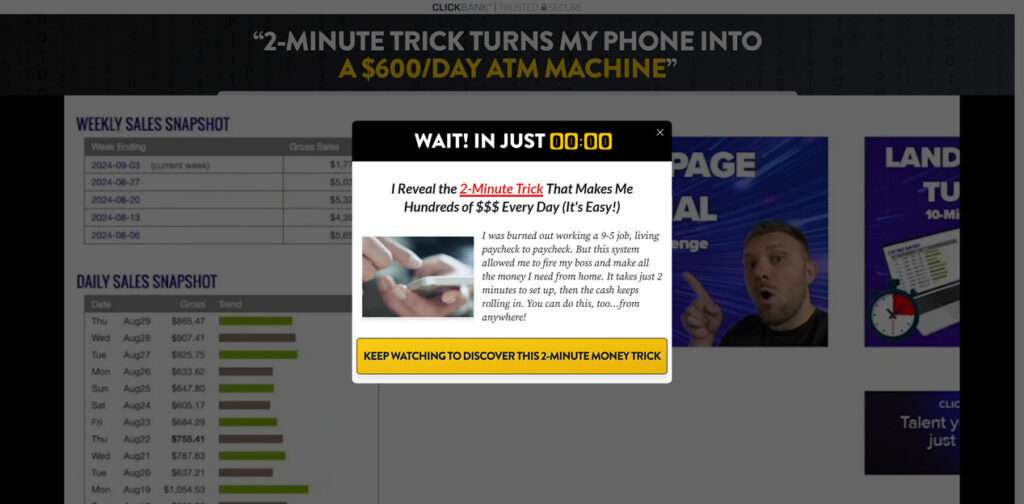Have you seen social media ads promising that a “2-minute phone trick” can turn your device into a personal ATM machine generating hundreds per day? As alluring as it sounds, this is a deceitful scam you should steer clear of.
In this extensively researched article, we uncover how cybercriminals are exploiting the Mini Mobile ATM scam, luring unsuspecting social media users through fabulous claims of easy money. You’ll learn about their devious techniques and how to protect yourself from such frauds.

Mini Mobile ATM Scam
In the digital age, making money online continues to be a major allure, with many chasing the dream through convenient apps and systems. However, numerous scams still abound, preying on the human tendency to seek fortune with minimal effort.
One such scam currently circulating widely is the “Mini Mobile ATM 2-Minute Phone Trick.” Using fabricated stories and ads on social platforms, this scam tricks victims into paying for a non-existent money making scheme.
But can a simple 2-minute phone trick really convert your device into an ATM machine, as promoters assert? Let’s analyze the reality behind this scheme and how it fleeces trusting individuals through deception and exploitation.
Overview
The Mini Mobile ATM scam relies primarily on social media ads and fake reviews to peddle the illusion of a “2-minute phone trick” that can make users hundreds daily.
Promotional posts typically read, “This 2-minute trick makes me $600 a day just by using my phone,” often accompanied by fake testimonials of people who supposedly earned fortunes in no time.

When users click on these ads, they are redirected to websites like MiniMobileATM.com or MobileMagicSystem.co. These showcase more fabricated stories and AI-narrated videos making bold claims about turning phones into money-minting machines.
To access the “secret” trick, people are asked to pay a small one-time fee, usually $47. However, this leads to recurring monthly charges for a training program that provides no real value.
The domains hosting such scams use privacy services to hide the owner’s identity. Any attempt at cancellations or refunds is met with resistance or non-response.
Recurring Tactics Used in the Scam
The Mini Mobile ATM scam exhibits typical behaviors seen in many online financial frauds:
- Fake social proof – Scripted success stories and doctored payment screenshots are used to falsely demonstrate others’ financial gains via the system.
- Authority-building tactics – Scammers add badges like “Licensed Company” and “Secured Website” to subconsciously build trust and credibility.
- Vague promises – Claims like “Make money from your phone” or “Tap into the internet money rush” give false hope without offering anything concrete.
- Artificial scarcity – Phrases like “limited slots available” pressure people into signing up quickly out of fear of missing out.
- Hidden fees – An initial $47 fee balloons into $97 monthly charges without warning, deducted automatically via obscure terms and conditions.
These psychological tricks exploit human emotions and financial desires to convince victims that the Mini Mobile ATM offers easy income versus the financial fraud it is.
How the 2-Minute Phone Trick Scam Actually Works
While ads claim you can make money within two minutes of using a simple phone trick, the reality is very different. Here is the step-by-step process of how the 2-minute phone trick scam operates:
Step 1: Hook with Outrageous Claims
Social media ads use sensational claims of generating $600+ daily through a two-minute mobile phone trick. The headlines spark interest by promising unbelievable earnings with barely any effort.
Step 2: Drive to Deceptive Websites
Intrigued users click on the ads and land on sham websites like MiniMobileATM.com that reinforce the outlandish claims using fake testimonials and authority-building tactics.

Step 3: Get Victims to Pay Initial Fee
After convincing visitors that the mobile trick works, the sites prompt them to pay a small one-time fee of $47 to unlock access. People pay, believing this is too cheap to be a scam.
Step 4: Auto-Enroll in Recurring Fees
Buried in obscure terms and conditions, paying the $47 enrolls users in expensive monthly subscriptions without consent. Fees of up to $97 are deducted automatically via saved payment details.
Step 5: Provide Vague, Generic Training
For the fee, people gain access to generic, copy-pasted “training” videos and PDFs that offer no unique money-making insights. The promised personal ATM system is non-existent.
Step 6: Ignore Refund Requests
When users inevitably ask for refunds after realizing it’s a scam, emails and calls go unanswered, often citing a no refunds policy on digital products. Users are left paying expensive recurring fees.
This well-designed fraud relies on social engineering and misleading promises to profit at the expense of unsuspecting people. The promised shortcut to wealth never manifests.
This Isn’t the First Time We’ve Seen This Type of Scam
The Mini Mobile ATM scam bears an uncanny resemblance to a previous scheme called Printr and its deceptive “60-Second Phone Loophole” ploy.
Much like Mini Mobile ATM, Printr also made bold claims that people could easily earn hundreds per day just by using their phones for 60 seconds. Slick marketing videos promoted a magic system for generating income through minimal mobile effort.
Printr ads told improbable stories of ordinary people getting rich by accessing some secret “loophole” requiring less than a minute on their phones daily. Of course, the promised riches never materialized.
Our extensive investigation into Printr uncovered it as an elaborate hoax designed to charge victims recurring fees under false pretenses. We exposed the deception and fake reviews used to peddle this obvious fraud.
Now the fraudsters are back with a repackaged scam using the fresh name Mini Mobile ATM. But their devious tactics remain unchanged. Fabricated stories, phony authority-building, and hidden subscription charges continue being deployed to dupe trusting individuals.
It’s clear the masterminds behind both Printr and Mini Mobile ATM are one and the same. These online predators just alter names and websites periodically to evade scrutiny, while peddling essentially the same lies and charging unsuspecting people repeatedly for their bogus systems.
Avoiding the 2-Minute ATM Scam (Tips)
Here are some tips to safeguard yourself from predatory scams like the Mini Mobile ATM:
- Verify claims by seeking reviews outside the seller’s control. Seek scam warnings on forums.
- Check for transparency in seller identity, contact information, and policies around use of personal data.
- Be wary of “limited time offers” or other high-pressure sales tactics aimed at prompting quick purchases.
- Understand that online money-making requires real work and skill development versus miraculous apps or tricks.
- Install scam call and text blocker apps to avoid unsolicited promotion of phony schemes.
- Never pay unverified strangers on the internet upfront fees for income opportunities.
- Carefully read terms and conditions before purchases to check for auto-renewal or recurring charge clauses.
Exercising caution, skepticism and common sense is the best defense when navigating the myriad of disingenuous offers online. Scrutinize rather than swallow every money-making pitch you encounter.
Recourse If You Already Paid
If you paid the Mini Mobile ATM scammers, here are some steps to immediately mitigate damages:
- Report Fraud – Alert relevant authorities about being victimized by an online financial scam. Provide all details available.
- Cancel Subscriptions – If signed up for recurring plans, look for fine print allowing you to cancel upcoming auto-payments.
- Initiate Refunds – Send formal refund requests via email to every contact available, citing that you were misled.
- Issue Chargebacks – If refund requests are ignored, contact your bank or credit card provider to report fraudulent charges.
- Leave Reviews – Post scam warnings for Mini Mobile ATM on consumer forums and app store reviews to protect other users.
- Monitor Accounts – Keep monitoring bank accounts and credit reports for signs of any further suspicious charges.
Catching and addressing the problem promptly can help limit financial losses from online scams. But prevention remains the best solution.
FAQ: Uncovering the Mini Mobile ATM “2-Minute Phone Trick” Scam
1. What is the Mini Mobile ATM “2-Minute Phone Trick” scam?
The Mini Mobile ATM scam claims that a simple 2-minute phone trick can transform your mobile device into an ATM machine generating hundreds of dollars per day. However, it is a fraudulent scheme designed to charge victims recurring fees under false pretenses.
2. How does the Mini Mobile ATM scam work?
This scam uses fake social media ads and fabricated stories to convince people to visit websites like MiniMobileATM.com. After getting victims to pay a small initial fee, monthly charges up to $97 are deducted automatically without consent, while providing only generic, worthless information.
3. What claims are made in this scam?
Ads state that with a revolutionary “2-minute phone trick,” anyone can make $600+ daily by turning their phones into personal ATMs. Fake reviews and success stories are showcased as proof these claims work.
4. Are these claims true?
No, the promises of easy money through a simple 2-minute mobile trick are completely bogus. No actual app or money-making system exists. The reviews, videos, and materials provided are fabricated to lure victims.
5. Who is behind the Mini Mobile ATM scam sites?
The real people behind this scam hide their identity by registering sites anonymously and using privacy services. They provide no contact information and ignore refund requests, making it a clear fraud.
6. What are the costs of the Mini Mobile ATM scam?
Victims must pay a deceptive one-time fee of $47, which secretly signs them up for expensive recurring monthly charges of up to $97 billed repeatedly to their credit cards without consent.
7. What do you get for your money?
You only get access to generic, copy-pasted videos and PDFs providing no unique or valuable instruction on making money. The ATM system promised does not exist.
8. Can you really make money through a 2-minute phone trick?
No, the concept of a simple 2-minute phone trick turning your device into an income-generating ATM machine is patently false. No such miraculous system exists without real work.
9. How can I avoid the Mini Mobile ATM scam?
Be wary of too-good-to-be-true offers online. Check site reputation via objective reviews. Verify seller identities. Understand legal terms before purchasing. Never pay unverified strangers upfront fees.
10. What should I do if I already paid money to this scam?
If you paid them already, contact your bank immediately about fraudulent charges. Request refunds in writing citing deception. Leave negative reviews about your experience to warn others.
The Bottom Line
The Mini Mobile ATM scam preys on unsuspecting social media users through deceptive ads and websites promoting a non-existent “2-minute phone trick.” Lured by stories of easy income, victims end up paying recurring fees for generic, worthless information.
In reality, no shortcut can transform phones into ATM machines. Any offer promising easy money with little effort should raise red flags. Protect yourself by verifying seller credibility, reading terms carefully, and never paying unverified people upfront.
With vigilance and discretion, you can avoid falling for lies peddled by exploitative scams like the Mini Mobile ATM. Don’t let glossy ads and fabulous claims blind you – if it seems too good to be true, it almost always is.










